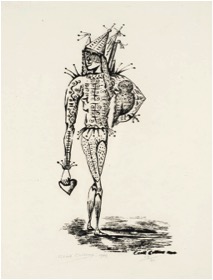Post by HLTD51 student KAKhalfan
Ageism is the process whereby older adults are viewed from a negative perspective regarding all the different attributes they possess. Whether these attributes are psychological, social or biological, the negative perceptions remain constant and present within our society. For example, from an ageist perspective “older adults are viewed, among others, as irritable, boring, grumpy, weak, mournful, debilitated, and most importantly cognitively impaired” (Coudin & Alexopolous, 2010). Consequently, these stereotypes have embodied the influence and power that shape the functioning of older people (Coudin & Alexopolous, 2010).
The predominance of older people viewed as cognitively impaired seems salient in Philip Larkin’s poem “The Old Fools”. Fools are individuals who are unwise, imprudent and forgetful; all of which some individuals may attribute to cognitively impaired individuals. This ageist attitude transitions from the title and into the first two stanzas of the poem. For example, in the first stanza Larkin says “[…] and can’t remember/Who called this morning”. This suggests that like cognitively impaired individuals, older people lack the ability to recall information. Another example occurs in the second stanza when Larkin says “[…] And these are the first signs:/Not knowing how, not hearing who, the power/Of choosing gone”. Similarly to the former example, this implies that older people cannot sustain the mental capacity of memory recall and auditory stimulation, again equating older people to cognitively impaired individuals.
*
Negative-aging stereotypes have consequences on the aging experience of older adults. For example, older adults’ performance on tasks declines when primed with negative-aging stereotypes (Coudin & Alexopolous, 2010). Similarly, negative-aging stereotypes deteriorated the handwriting quality of older adults, implying detrimental effects on personality and physical condition (Coudin & Alexopolous, 2010). Additionally, older adults exposed to negative-aging stereotypes attribute their health as worse than the health of other older adults without this exposure (Coudin & Alexopolous, 2010). Thus, it is evident that when older adults are exposed to negative-aging stereotypes many different consequences arise on their functioning and experiences. Through these results, it seems plausible to question and ostracize Larkin as he replicates ageist perspectives.
However, initial readings of Larkin’s poem and our knowledge on the outcomes of negative-ageing stereotypes are not justifiable to attest the poem as worthless and Larkin as an ageist. During my first few readings of the poem, I too thought that I was justified to dismiss Larkin, as the poem seems to explicitly disregard the implications negative stereotypes produce on the health and wellbeing of older adults. However, as I continued to read the poem and ignore my positive emotions toward older people, I began to understand the true purpose of Larkin’s poem: To change the trajectory of what it means to age. From this redirection, Mary Russo’s conceptualization of anachronism became prevalent in my understanding of Larkin’s grotesque and unsubtle use of the negative-aging stereotypes.
Russo (1999) defines anachronism as “a risk which is both necessary and inevitable as a sign of life” (21). This is of particular importance as “Not acting one’s age, for instance, is not only inappropriate but dangerous” (21). This danger is what Russo (1999) believes to result in the acceptance of being ‘socially old’ and the implications that come with it. These implications include Larkin’s references to drooling and urinating on oneself while simultaneously reminiscing about the past. It is through these implications that one continues down the steady trajectory of aging until death pays it dues. However, Russo (1999) contests against the life course model of progression toward death by advocating for individuals to act ‘against’ one’s age by bypassing the normative understanding of aging. Keeping salient Russo’s request for anachronism, individuals can begin to understand the reasons for Larkin’s grotesqueness displayed in the poem.
Through the use of the rhetorical question and by subjecting ‘the old fools’ to “they” in the first and second stanzas, Larkin makes it evident that this poem is not for the current older people but rather for the future generations of older people. Larkin purposefully tries to be as unsubtle and unfiltered as possible as a plea for younger people to age against the normative understanding of what it means to grow old. Larkin fears that through reminiscing with past memories, older people are essentially wasting their time and waiting for their death to occur. This notion of reminiscence as wasting one’s time is evident in the poem when Larkin says, “We had it before, but then it was going to end”. The ‘We’ suggests that he is speaking from the older person’s perspective to assist the younger reader in understanding that following the life course trajectory leads to the expectation of death.
Drawing upon Russo’s (1999) conceptualization of anachronism, Larkin’s poem transitions from a seemingly ageist poem to a poem that seeks to change the life course trajectory of future older generations. Russo (1999) ultimately encourages the risk of defying the “cultural expectations of decrepitude and death” (Chivers, 2018, p. 213). Larkin choses to defy these expectations through the use of grotesque language, ageist stereotypes, rhetorical questions, and shifting pronouns, to inspire and evoke fear in young individuals to pursue against the gradient of older age as waiting for death.
